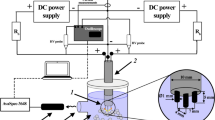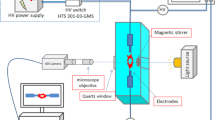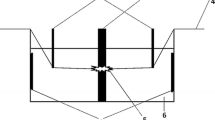Abstract
Underwater impulse plasma can be used for one-stage production of composite polymer materials containing metal oxide nanoparticles. It was found that the electrode sputtering rate and the phase composition of the formed particles depend on the medium in which the discharge burns: water or a polymer solution. The stages of the formation of an underwater discharge impulse were discussed and the discharge parameters were determined, such as the current density, the field strength in the plasma, and the electron drift velocities. The energy distribution channels in the underwater impulse discharge are analyzed, and it is established that about half of the input energy is spent on heating the solution. The totality of the obtained data can be used in the development of technological foundations for the use of pulsed underwater discharges in the industrial synthesis of polymer nanocomposites.








Similar content being viewed by others
References
Dinari M, Nabiyan A (2017) Citric acid-modified layered double hydroxides as a green reinforcing agent for improving thermal and mechanical properties of poly (vinyl alcohol)-based nanocomposite films. Polym Compos 38:E128–E136
Marangoni R, da Costa Gardolinski JEF, Mikowski A, Wypych F (2011) PVA nanocomposites reinforced with Zn2Al-LDHs, intercalated with orange dyes. J Solid State Electrochem 15:303–311
Singh VK, Annu A, Singh U, Singh P, Pandey SP, Bhattacharya B, Singh PK (2013) Dye sensitized solar cell based on poly (vinyl alcohol) doped with ammonium iodide solid polymer electrolyte. J Optoelectron Adv Mater 15:927–931
Vo TK, Park HK, Nam CW, Kim SD, Kim J (2018) Facile synthesis and characterization of γ-AlOOH/PVA composite granules for Cr (VI) adsorption. J Ind Eng Chem 60:485–492
Zhao CX, Liu Y, Wang DY, Wang DL, Wang YZ (2008) Synergistic effect of ammonium polyphosphate and layered double hydroxide on flame retardant properties of poly (vinyl alcohol). Polym Degrad Stab 93:1323–1331
Khlyustova A, Sirotkin N, Kraev A, Titov V, Agafonov A (2021) Parameters of underwater plasma as a factor determining the structure of oxides (Al, Cu, and Fe). Materialia 16:101081
Sirotkin NA (2022) Creation of polyvinyl alcohol-based polymeric composite nanomaterials using pulsed underwater discharge plasma and their application in photovoltaic. Int J Appl Fundam Res 4:45–50
Khlyustova A, Sirotkin N, Titov V, Agafonov A (2020) Comparison of two types of plasma in contact with water during the formation of molybdenum oxide. Curr Appl Phys 20:1396–1403
Khlyustova A, Sirotkin N, Kraev A, Agafonov A, Titov V (2021) Effect of metal oxides added onto polyvinyl alcohol via pulsed underwater plasma on their thermal, electrical and dielectric properties. J Appl Polym Sci 138:51174
Sirotkin N, Khlyustova A, Costerin D, Naumova I, Kalazhokov Z, Kalazhokov K, Titov V, Agafonov A (2022) Synthesis of chitosan/PVA/metal oxide nanocomposite using underwater discharge plasma: characterization and antibacterial activities. Polym Bull. https://doi.org/10.1007/s00289-022-04348-2
Agafonov AV, Sirotkin NA, Titov VA, Khlyustova AV (2022) Low-temperature underwater plasma as an instrument to manufacture inorganic nanomaterials. Russ J Inorg Chem 67:253–261
Sirotkin NA, Gurina DL, Khlyustova AV, Costerin DY, Naumova IK, Titov VA, Agafonov AV (2021) Experimental and computational investigation of polylactic acid/silver-NP nanocomposite with antimicrobial activity prepared by plasma in liquid. Plasma Proc Polym 18:2000169
Sirotkin N, Khlyustova A (2022) The oxide nanostructures formation mechanisms in underwater plasma in terms of electrochemistry. Plasma Chem Plasma Process 42:1003–1013
Ushakov VI (ed) (2007). Springer, Berlin
Lide DR, Baysinger G, Chemistry S, Berger LI, Goldberg RN, Kehiaian HV (2004) CRC handbook of chemistry and physics. CRC Press, London
Troughton S, Nominé A, Nominé A, Henrion G, Clyne T (2015) Synchronised electrical monitoring and high-speed video of bubble growth associated with individual discharges during plasma electrolytic oxidation. Appl Surf Sci 359:405–411
Grosse K, Held J, Kai M, von Keudell A (2019) Nanosecond plasmas in water: ignition, cavitation and plasma parameters. Plasma Sources Sci Tech 28:085003
Bruggeman P, Schram D, González MA, Rego R, Kong MG, Leys C (2009) Characterization of a direct dc-excited discharge in water by optical emission spectroscopy. Plasma Sources Sci Tech 18:025017
Dyatko NA, Kochetov IV, Napartovich AP, Sukharev AG (2015) EEDF: the software package for calculations of the electron energy distribution function in gas mixtures. http://www.lxcat.net/software/EEDF/
Dyatko NA, Kochetov IV, Napartovich AP (2014) Non-thermal plasma in stabilities induced by deformation of the electron energy distribution function. Plasma Sources Sci Tech 23:043001
Bruggeman P, Leys C (2009) Non-thermal plasmas in and in contact with liquids. J Phys D Appl Phys 42:053001
Griem HR (1997) Principles of plasma spectroscopy. Monographs on Plasma Physics. Cambridge University Press, Cambridge
Konjević N, Ivković M, Sakan N (2012) Hydrogen Balmer lines for low electronnumber density plasma diagnostics. Spectrochim Acta Part B At Spectrosc 76:16–26
Gigosos MA, González MA, Cardeñoso V (2003) Computer simulated Balmer-alpha, -beta and -gamma Stark line profiles for non-equilibrium plasmas diagnostics. Spectrochim Acta Part B At Spectrosc 58:1489–1504
Hermanns P, Boeddeker S, Bracht V, Bibinov N, Awakowicz P (2020) In-situ control of microdischarge characteristics in unipolar pulsed plasma electrolytic oxidation of aluminum. J Phys D Appl Phys 53:435204
Hillebrand B, Iglesias E, Gibson AR, Bibinov N, Neugebauer A, Enderle M, Awakowicz P (2020) Determination of plasma parameters by spectral line broadeningin an electrosurgical argon plasma. Plasma Sources Sci Tech 29:125011
Djurović S, Konjević N (2009) On the use of non-hydrogenic spectral lines for low electron density and high-pressure plasma diagnostics. Plasma Sources SciTech 18:035011
Kunze H-J (2009) Introduction to plasma spectroscopy. Springer, Cham
Shen VK, Siderius DW, Krekelberg WP, Hatch H, (Eds) (2022) NIST standard reference simulation website, NIST standard reference database number 173, National institute of standards and technology Gaithersburg MD 20899
Bruggeman PJ, Sadeghi N, Schram DC, Linss V (2014) Gas temperature determination from rotational lines in non-equilibrium plasmas: a review. Plasma Sources Sci Tech 23:023001
Diatomic 1.4.1.1, (2011) Cyber wit diatomic: database and simulation program. www.cyber-wit.com Cited 2011
Bruggeman P, Verreycken T, González MA, Walsh JL, Kong MG, Leys C, Schram DC (2010) Optical emission spectroscopy as a diagnostic for plasmas in liquids: opportunities and pitfalls. J Phys D Appl Phys 43:124005
Wang J, Simeni MS, Rong M, Bruggeman PJ (2021) Absolute OH density and gastemperature measurements by laser induced fluorescence in a microsecond pulseddischarge generated in a conductive NaCl solution. Plasma Sources Sci Tech 30:075016
Hussein RO, Nie X, Northwood DO, Yerokhin A, Matthews A (2010) Spectroscopic study of electrolytic plasma and discharging behaviour during the plasma electrolytic oxidation (PEO) process. J Phys D Appl Phys 43:105203
Nikiforov AY, Leys C, Gonzalez MA, Walsh JL (2015) Electron density measurement in atmospheric pressure plasma jets: stark broadening of hydrogenated and non-hydrogenated lines. Plasma Sources Sci Tech 24:034001
Laux CO, Spence TG, Kruger CH, Zare RN (2003) Optical diagnostics of atmospheric pressure air plasmas. Plasma Sources Sci Tech 12:125
Koutoula SG, Timoshkin IV, Judd MD, MacGregor SJ, Wilson MP, Given MJ, Wang T, Harrison EI (2016) A study of energy partition during arc initiation. IEEE Trans Plasma Sci 44:2137
Khlyustova A, Sirotkin N, Evdokimova O, Prysiazhnyi V, Titov V (2018) Efficacy of underwater AC diaphragm discharge in generation of reactive species in aqueous solutions. J Electrostat 96:76–84
Izdebski T, Dors M, Mizeraczyk J (2014) Energy emissions of spark discharge underwater. Eur Chem Bull 3:811
Buogo S, Plocek J, Vokurka K (2009) Efficiency of energy conversion in underwaterspark discharges and associated bubble oscillations: experimental results. Acta Acoust 5:46
Author information
Authors and Affiliations
Corresponding author
Additional information
Publisher's Note
Springer Nature remains neutral with regard to jurisdictional claims in published maps and institutional affiliations.
Rights and permissions
Springer Nature or its licensor (e.g. a society or other partner) holds exclusive rights to this article under a publishing agreement with the author(s) or other rightsholder(s); author self-archiving of the accepted manuscript version of this article is solely governed by the terms of such publishing agreement and applicable law.
About this article
Cite this article
Sirotkin, N., Khlyustova, A. The Electrophysical Characteristics of Underwater Impulse Discharge Plasma in the Processes of Creating Multifunctional Composites. Plasma Chem Plasma Process 43, 561–575 (2023). https://doi.org/10.1007/s11090-023-10329-8
Received:
Accepted:
Published:
Issue Date:
DOI: https://doi.org/10.1007/s11090-023-10329-8




